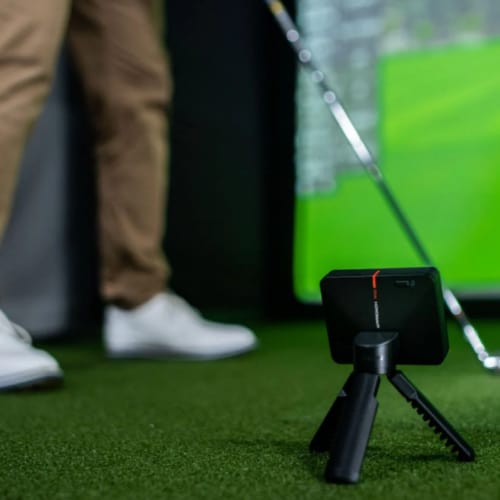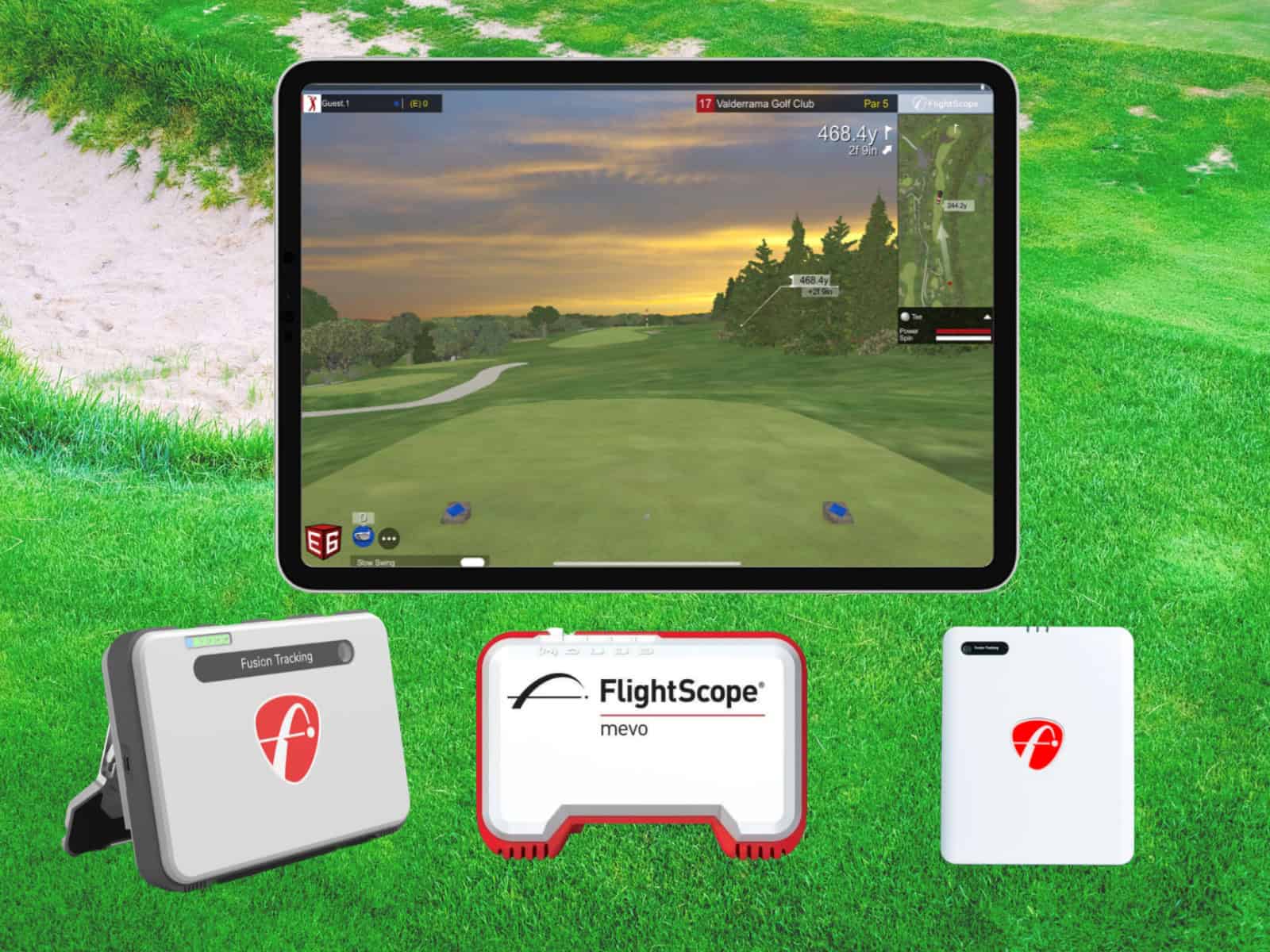High-end golf simulator setups featuring top-of-the-line launch monitors, high-definition projection screens, and premium simulation software can cost upwards of $50,000 to construct at home. However, much more affordable DIY and off-the-shelf simulator packages are also available for golfers working with a tighter budget.
This article explores some of the cheapest golf simulator options on the market for those looking to build an indoor golf environment on a budget.
Lower-priced standalone launch monitors provide swing analysis and shot feedback starting around $500 without the need for external screens or software.
Complete simulator bundles also exist featuring mats, enclosures, sensors, and graphics in the $500 to $2,000 range, though the technology is scaled back compared to higher-end setups.
Opting for a low cost DIY build using standalone simulator components is another method to help control costs for your own needs and space.
We will cover some of the most wallet-friendly gear, packages, and constructions available to build a basic indoor golf simulator for under $2,000 in 2026 without sacrificing too much quality.
Why Invest in a Cheap Home Golf Simulator?

There are many benefits to having your own golf simulator at home, especially on a budget:
- Practice Year-Round: Rain or shine, you can work on your golf game without leaving the house. No need to worry about booking tee times or range buckets. Just walk downstairs and swing away.
- Analyze to Improve: Many budget simulator options still provide swing analysis tools to check your club speeds, launch angles, shot dispersion, and other key metrics. They help you dentify weaknesses to train more efficiently.
- Play in a Virtual World: While graphics might not be as sharp as premium simulators, you still get to play rounds on famous courses you may never get to in real life.
- Entertain Friends and family: A simulator is a huge draw for golf lovers to come over and have fun competing against each other at home. Perfect for rainy days or winter months when outdoor activity is limited.
For any passionate golfer or someone looking to pick up the game, a budget DIY home simulator lets you make the most out of practice time for less. Advanced options have gotten cheaper in price without too many compromises on overall performance.
With some strategic planning around space needs, construction, required gear, and extras like mats or screens, installing an affordable simulator for a few thousand dollars or potentially less is now very achievable.
Budget Standalone Launch Monitors
For golfers focused purely on improving swing technique and analyzing shot data, standalone launch monitors provide performance feedback without the need for any external screens, enclosures, or simulation software. These portable monitors use radar or camera technology to track key shot information like club head speed, ball velocity, launch angle, spin rate, and more. They connect to smartphones or tablets to display the measured data after each shot.
Affordable standalone launch monitors range from $500 to $2,000, delivering useful swing and ball flight metrics at a fraction of the cost of full golf simulator packages. The compromise is losing the immersive virtual golf experience and entertainment value. But for practice and analysis, launch monitors pack impressive technology into small, affordable devices.
Here are a few examples:
Rapsodo Mobile Launch Monitor

The Rapsodo Mobile Launch Monitor is an ultra-portable device that connects to your smartphone and provides shot tracing and metrics through a connected mobile app. For around $500, it measures club speed, ball speed, smash factor, launch angle, spin rate, shot dispersion, and other stats critical to fine-tuning your game. An included stand grips onto your mobile device to display the visuals and data. While the accuracy doesn’t match top-end radar models, it’s a bargain for the amount of feedback provided.
Rapsodo recently launched an upgrade to the MLM in the form of the Rapsodo MLM2 pro, which provides improved performance and accuracy. It also costs more than its predecessor.
Garmin Approach R10 Launch Monitor

Garmin’s Approach R10 slots in as an entry-level but surprisingly capable launch monitor and portable golf simulator. It’s billed as a “launch monitor that fits in your pocket” thanks to its ultra-compact size and minimal footprint – perfect for tossing in your golf bag. Using radar technology and intelligent analytics, the Approach R10 tracks all the crucial shot data to improve your golf game through insights on any club in your bag.
Despite a sub-$600 price tag, the Approach R10 accurately tracks club speed, ball speed, smash factor, launch angle, distance, and more. It provides shot history to spot trends as well as virtual competitions to add motivation. Using Garmin’s app, data is conveyed clearly post-swing to track progress over time. That level of useful insight is remarkable for such an affordable and portable unit.
SkyTrak Launch Monitor

For more advanced golfers, the SkyTrak Launch Monitor provides highly accurate, advanced shot analysis, albeit at a higher cost. It accurately measures useful data points and integrates with the SkyTrak simulator software and other 3rd-party software for full-game simulation.
The base package starts at around $2,900 but rivals monitors costing far more. SkyTrak truly helps dial in your ball-striking, shot patterns, and club metrics through precision measurement and feedback.
An upgrade to the original Skytrak has been released, which provides enhanced accuracy and tracking through a dual Doppler and photometric system. The Skytrak Plus launch monitor costs now around 50% more than its predecessor, but it truly provides a better overall experience.
Flightscope Mevo + Launch Monitor

The FlightScope Mevo+ represents a great personal launch monitor balancing high accuracy with real-world usability for amateur and advanced golfers alike. Using advanced Doppler radar and sensor fusion technology, the Mevo+ comprehensively tracks both club delivery and resulting ball flight. It conveys metrics like club speed, angle of attack, smash factor, launch angle, ball speed, spin rate, descent angle, apex height, carry distance, total distance, etc.
With a measurement accuracy cone of +/- 1 foot, the Mevo+ even rivals more expensive stationary launch monitors costing over $10k. It’s fully functional both indoors and outdoors thanks to a rechargeable battery and included stand. Easy portability expands your practice options. For under $2k, the feature set impresses.
These budget-friendly launch monitors can be paired with a cheap hitting mat and a golf net to allow for practice both indoors and outdoors. We suggest going with something like the Swingturf Hitting Strip and the SwingNet® Lite Golf Net.
Basic Golf Simulator Packages
For golfers seeking an affordable plug-and-play indoor golf experience, complete simulator packages bundle together all the necessary elements like nets or screens, mats, sensors, and software. Prices range from around $400 to $1,000 for these all-in-one budget-friendly sets. Just set up the enclosure, calibrate the sensors, and you’re hitting virtual shots in your own simulator bay.
Basic simulator packages offer impressive functionality considering the cost. The compromise comes in dimensions for play space, sensor precision, and simulation realism. But for many golfers, these packages deliver good bang for the buck.
OptiShot 2 Golf Simulator

The OptiShot 2 Golf Simulator is one of the most affordable complete golf simulator options available today. It uses infrared sensors to track club data. Included are a realistic hitting mat, net, and simulator software to play 15 global courses.
Accuracy is limited compared to radar and ball flight visualization also has some flaws, but for the price, it brings basic simulation capability indoors.
The most affordable Optishot packages include the Golf In A Box Package ($800) and the Golf In A Box 2 ($1,200). Other packages come with screens and projectors, but they exceed the $3,000 mark.
GoSports Golf Practice Package

If you already own a launch monitor, you can turn it into a full simulator setup with the GoSports Golf Practice Package. This package comes with side netting, ceiling netting, and a hitting mat for a bit over $1,000. Add your preferred launch monitor and you have a practice system.
While still a budget build, it allows flexibility to integrate higher-end components down the road.
This is the same combo found with budget systems like the Rapsodo MLM2Pro Practice Package and the Garmin Approach R10 Practice Package.
Exputt EX500 Real-Time Putting Simulator

The Exputt EX500 Putting Simulator provides an effective yet wallet-friendly indoor putting lab for improving skills. Using advanced sensors and swing analysis software, the EX500 instantly identifies strengths and trouble spots with accurate metrics. Key data like face angle at impact, swing path direction, and ball speed fuels measurable improvement whether refining mechanics or reading tricky putts.
Benefits span beyond the numbers through video recording and adjustable putting green speeds. Save videos of strokes synchronized with graphics revealing face angle, swing path and impact spot – this visual feedback accelerates developing sound putting technique. And with variable stimpmeter simulation from 8 – 15 ft, you can practice lag putting or firm downhillers tailored to any green speed. For under $500, the EX500 simulator simplifies practice with instant, multifaceted feedback.
DIY Golf Simulator Options
Golfers with some technical skill and willingness to research and source components can construct a custom golf simulator by piecing equipment together. Taking the DIY route gives flexibility to balance cost and functionality at your desired level. While requiring more effort upfront, you can build an enclosed bay tailored to your space, performance needs, and budget.
Constructing a DIY simulator allows mixing and matching items like:
- Impact screens
- Hitting mats
- Enclosure netting
- Launch monitors
- Projectors
- Computers
- Simulation software
Materials/Equipment Needed
For a complete DIY simulator, you will need the following:
Impact Screen – A basic screen starts around $300. Higher-end 4K-ready models are available, too. The larger, the pricier.
Enclosure Netting – Netting frame kits start at $500. Ensure proper height and depth for club swing.
Launch Monitor – Choose from relatively affordable models like SkyTrak, Mevo+, or Voice Caddie models ($500-$2,000).
Projector – Short-throw models under $1,000 work well. Ensure lumens match ambient lighting for the projected images to be clear and visible.
Computer & Software – Any powerful PC/laptop can run the simulator software decently; a software license may cost you around $200+, depending on the features and included virtual courses.
Estimated Cost

Total cost can range from $2,000 to $4,000+ depending on the performance level of the gear selected. Top-of-the-line components push the budget up quickly. Integrating used items also helps with costs. You might opt for used launch monitors and projectors if you are on a really tight budget.
The main advantage of a DIY build is customizing and improving pieces over time. Start with basic components that fit your budget today, while keeping future upgrade paths open as funds allow. To help you out, we suggest checking our guides on building a custom DIY golf sim enclosure and how to build a golf simulator.
Final Thoughts & Recommendations
By making some compromises in technology, dimensions, or functionality, golfers on tight budgets can put together basic solutions for under $2,000.
Standalone launch monitors provide excellent value for practice and swing analysis. Models like the Rapsodo and SkyTrak start around $500 and $2,000 respectively. While missing the entertainment value of simulation, they deliver robust measurement and data.
Complete simulator bundles also bridge the gap for entry-level indoor golf. The OptiShot packs infrared sensors, a mat, and playable courses with a starting point of $800 and up. Cage frame systems from GoSports also allow DIY integration of preferred components.
While budget-friendly models offer a good start, you might wonder how they compare to higher-tier systems in terms of features and realism. If you’re interested in discovering how to elevate your at-home golf experience with the latest technology, check out our article on the top rated home golf simulators for an in-depth look at this year’s best models.
For the best balance of cost and quality, constructing a custom simulator using a modular, mix-and-match approach enables building to your exact specs and budget. As funds allow over time, pieces can also be upgraded.
Finally, we suggest going through our dedicated articles with golf sims costing under $300, under $500 and under $2,000; these guides will definitely help you choose a budget-friendly system that suits your needs.
Thanks for reading!





